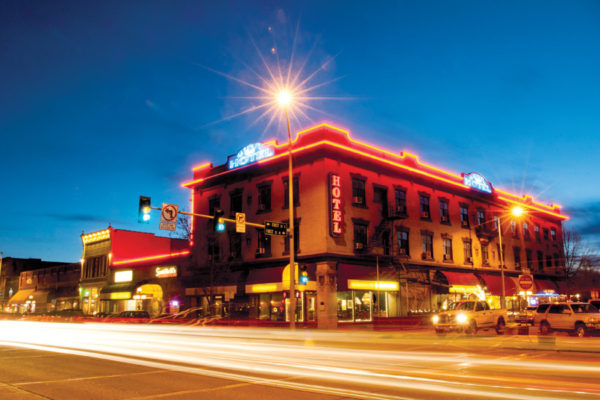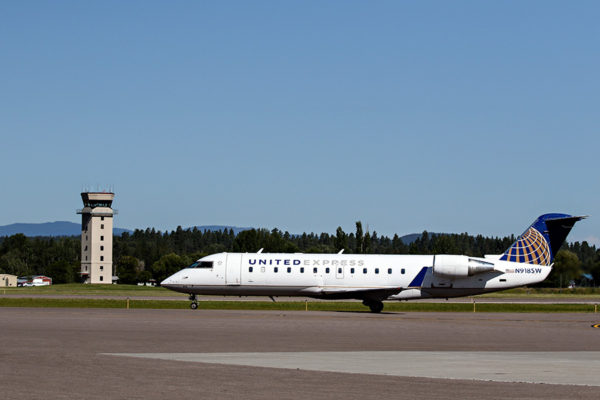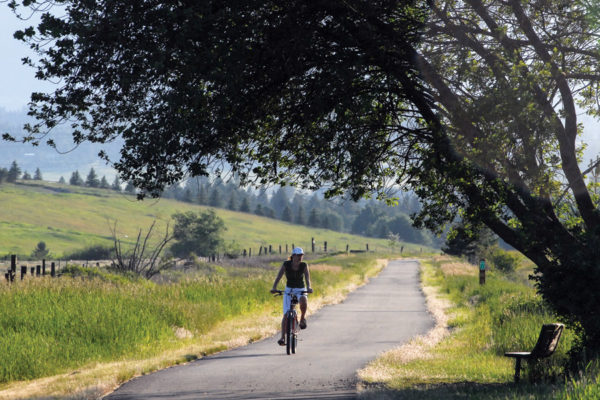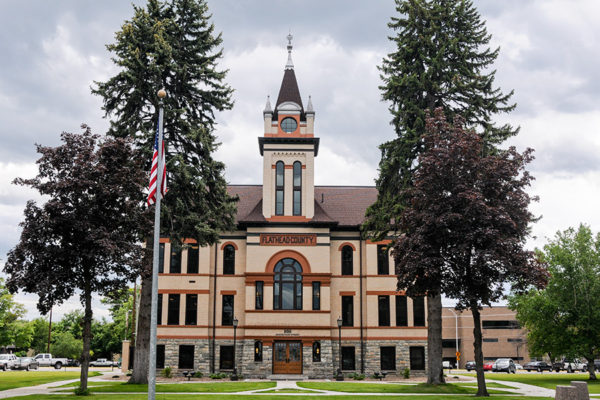Talking to the mayor of Bend, Oregon, about the top characteristics and concerns that have defined Deschutes County over the last few decades of rapid growth paints a familiar picture for anyone living in Flathead County.
A former timber town nestled in a scenic mountain landscape off the Interstate Highway System, with a vast outdoor recreation playground and a two-year community college in the county seat, evolves into a diverse economy that entices business professionals, young families and retirees all seeking a high quality of life. As a result, this success leads to growing pains such as strained infrastructure, traffic congestion and debates over urban sprawl, affordable housing, and preserving historical integrity.
Sound familiar?
In many ways, Deschutes and Flathead counties resemble long-lost siblings, a pair of Pacific Northwest communities that may not know it but share notable traits and trends. In this case, Deschutes would be the older of the two, maturing first while the smaller Flathead follows a similar trajectory a few years behind.
“I grew up here and I’ve seen it change so much, from about 20,000 people (in the early 1990s) to 80,000,” says Casey Roats, a fourth-generation Bend resident and local business owner who recently took over as mayor.
“When I graduated high school, most people had to leave. Staying in town was not an option … Now we’re getting to be a more diverse economy. We’ve experienced breakneck growth. Boy, things are booming again.”
Bryce Ward, an economist at the University of Montana Bureau of Business and Economic Research, has lived in both western Oregon and western Montana and recognizes two peas in a pod. Both regions not only resemble each other, they represent a new economic trend that is reshaping the post-recession landscape in many parts of the country.
“What is it that drives the explosion of population growth in Bend, Kalispell and Bozeman?” Ward asks. “They are nice places to live.”
“The simple historical story was that we discovered gold or we discovered oil or timber and people showed up and cities boomed … Now, the new fundamental story is basically that quality of life has become more important.”
This emergent model — “people first, jobs follow” — is putting Flathead County on a path toward more prosperity in the years to come, Ward says.
It’s the reason the Flathead has experienced some of the best economic gains in Montana in recent years and why the population is growing at the second fastest rate in the state among counties with large cities, behind Gallatin County.
Whitefish continues to make strides – $63 million in development last year – while Columbia Falls also experienced strong gains. Meanwhile, Kalispell is coming off one of its busiest years on record for economic development, including $129 million worth of construction in 2016. More growth is on the horizon, especially in key sectors such as education, health care and housing. Across-the-board business growth is occurring, although it’s slightly reined in by a tight job market. Last summer saw a record 900 open job postings in the county.
Downtown Kalispell is enjoying its highest occupancy rate in decades with new storefronts both large and small filling up. Last week, the new Blue Samurai Sushi Bar and Grill opened on Main Street while a new brewery is in the works a block away and Coffee Traders is preparing to relocate down the street.
Kalispell city leaders and Montana West Economic Development are poised to achieve a revitalization plan for the core area in the next two years that could spark significant private investment in the city center, similar to other communities that crafted plans with goals and directives, such as Missoula.
“I absolutely think there is hope for downtown Kalispell,” Linda McCarthy, executive director of the Missoula Downtown Association, says. “There are a lot of great buildings and beautiful streets. There is a real opportunity to keeping growing.”
Growth almost always presents challenges and pitfalls that every city must navigate. Missoula and Bozeman, two Montana communities that have experienced significant growth, are facing affordability issues. The Flathead is still relatively affordable compared to most places, although housing is becoming an issue, according to Ward, the economist.
“The way you screw up is if you somehow trash the quality of life, which I think is hard,” Ward says. “So it’s much more likely to be if the affordability issue becomes too much of a problem and opportunities suffer.”
“The Flathead is a top 1 percent place to live. Places that have things people like, those places will do well,” he continues. “The question becomes, ‘How do we develop it?’”
Qualities of a Successful City
To gain perspective on other cities’ growth and development, the Beacon spoke with city planners, civic and business leaders and an economist across the region. Here are some of their secrets to success, many of which the Flathead Valley has already tapped into.

Vibrant Downtown
When Linda McCarthy was a young student at St. Matthew’s School on Main Street in Kalispell, it would have been hard for her to imagine most of her professional adult life would revolve around downtowns, specifically Missoula’s.
McCarthy, whose family moved from Kalispell to Dupuyer when she was young, has served as the executive director of the Missoula Downtown Association since 1999. Many look at Missoula’s downtown, defined by a large selection of storefronts, restaurants and professional buildings both historic and new, with envy.
Missoula is in the midst of a record development spending, and much of that growth is targeting its downtown, including a $150 million conference center along the river and $250 million worth of residential and commercial growth in the old sawmill district.
The growth and vitality in the classic core area of Missoula are not by accident, as McCarthy says. It also doesn’t happen over night.
“A decade ago, we didn’t have a comprehensive vision for downtown Missoula. We had redevelopment plans. We had block-by-block strategies for redevelopment. But we didn’t have a comprehensive vision,” she says.
The MDA spearheaded the creation of a downtown master plan that was costly — $450,000 — but has proven effective. The plan focused on everything from transportation to land use, parking, housing and open space.
“Having a master plan gives you the ability to share your future vision with potential investors. They see you have a vision and they know where you want to go and they want to invest in that,” she says.
McCarthy credits the help of many entities, including the city and the Missoula Business Improvement District, for bringing the master plan to life. There was a concerted effort with a community committee acting as the driving force, which prevented the plan from gaining dust, she says.
After all, nurturing a successful downtown can be complicated with all kinds of factors in play. Walkability is incredibly important, as are biker-friendly streets. But traditional traffic flow is equally critical.
“You want your downtown to be easily accessible by car. You want easy drive-and-park options,” she says, emphasizing the benefits of people parking once and then walking throughout downtown as the ideal scenario for businesses.
“People want to be downtown, where they can walk and eat and dine and shop,” she says.
Daryl Schliem, president and CEO of the Bozeman Area Chamber of Commerce, echoed McCarthy’s strategy and focus.
“A lot of people take for granted the importance of their downtowns,” he says.

Quality of Life Amenities
“Basically the fundamental story (of the changing economy) is that quality of life has become more important,” says Bryce Ward, an economist at the University of Montana Bureau of Business and Economic Research.
Ward is far from surprised when he considers the recent economic and population surge in Gallatin and Flathead counties, places situated next to national parks, vast forest landscapes and an abundance of outdoor recreation opportunities, such as ski resorts, trail systems and bodies of water. These types of outdoor havens are proving increasingly invaluable in a world where business opportunities don’t solely depend on traditional industries, such as natural resource extraction, and economic prosperity allows families to escape bustling city life.
In many ways, that’s the story of Bend, Oregon’s success. Just like Kalispell, Bend is away from the Interstate system. It’s a former timber town nestled along the Cascade Range. Yet in the last 25 years, the city’s population has skyrocketed from roughly 25,000 to more than 80,000.
Why?
“We are firmly in the lifestyle city category these days,” says Casey Roats, a fourth-generation resident of Bend and city councilor who took over as mayor in January.
“While we do have some industries that are developing, I think at this point and time, it’s fair to say the significant driver of in-migration to this community are people who are attracted to the outdoor amenities here.”
Amidst “breakneck growth,” Bend’s economy has diversified around its strengths and this has helped it become more resilient in the face of downturns, Roats says.
The successful transition from timber town to outdoor mecca has led to an infusion of younger workers and residents, which forces a city to adapt to changing demands and patterns. For example, the Bend city government is focused on addressing a housing shortage.
“It’s displacing the workforce,” he says.
The importance of protecting the integrity and identity of the city is also a priority of the city government, Roats says, and this has led to changing zoning standards that allow more density in the core area of town to stem some of the urban sprawl.
Ward, the economist in Missoula, sees many similarities between Bend and the Flathead Valley.
“People won’t stop liking mountains,” Ward says. “Places that have things people like, those places will do well.”

Build On Your Strengths
The city of Bozeman and surrounding Gallatin Valley have undergone the fastest growth and development in Montana over the last 25 years.
Montana State University is the largest in the state. The county as a whole benefits from the top tourist attraction in Montana — Yellowstone National Park — and draws the most nonresident visitors — and spending — in the state on an annual basis. The business landscape has rapidly expanded and diversified as well, driven by high-paying sectors such as technology.
The economic success is not a coincidence.
Brit Fontenot, director of economic development for the city of Bozeman, credits the efforts of many entities, including the city, county and local chamber of commerce, as well as the active business community.
Smart growth does not happen by accident, particularly at a time of significant transition.
“Montana is experiencing a generational shift. There are a lot of people retiring and a lot of openings available for workers. The jobs are changing and the way people work is changing,” said Fontenot.
“Our challenge in the Bozeman area is to create an environment that is conducive to the new generation of workers and what they’re interested in. Millenials are looking for a place to live and then something to do. That requires you to think a little differently. In Bozeman, we’re trying to play to our strengths. We really try hard to do what we do well and double down on that stuff.”
Fontenot said the city and its partners identified specific business sectors that it wanted to attract and help expand, based on the community’s values and identity. That included high-tech, health care, manufacturing, tourism and the outdoor industry.
“We try to celebrate our past and we have a rich agricultural history that is important to our community, to our university and this part of Montana. We want to celebrate that and embrace that,” he said. “But we also want to embrace the future, which is why we built a fiber optic network. It’s why we want to focus on the 21st century economy. In our estimation, that is where the future economy lies.”

Air Service
“Air transportation is very important,” says Daryl Schliem, president and CEO of the Bozeman Area Chamber of Commerce.
The Bozeman airport has become the busiest in Montana in recent years with new direct flights to Texas, increasing the total direct services to 15 destinations. Schliem credits the partnership among the business community and the airport to offer revenue guarantees to carriers, helping increase the attractiveness of sending planes to Montana. As a result, the increased air service boosts nonresident tourism and helps the business community, he says.

Quality Infrastructure
“Businesses do not want to be where there is no infrastructure, like water, sewer, schools, civic and municipal facilities. You can really tell a lot about a community by looking at its library, for example. These are facilities that demonstrate the values of a community,” said Brit Fontenot, director of economic development for the city of Bozeman.

City Policy & Community Vision
In the early 2000s, the city of Missoula overhauled many of its rules and regulations in regards to development. The framework was considered by many to be too stringent in some regards and obsolete in others, and the variances created friction among community members and prospective developers, with City Hall positioned in the middle.
“One thing I heard over the years as a council member was that we had rules and regulations that were antiquated. We had some organizational issues that made it more difficult to pursue quality development,” John Engen, Missoula’s mayor since 2005, says.
Specifically, the city underwent a “comprehensive retooling of its zoning codes,” Engen says. It also focused intently on its growth policy, a vast planning document that guides growth and sets a community vision for a city’s evolution into the future. Missoula’s growth policy identified transportation needs and community desires, such as preserving open space, improving walkability through trail systems and increasing density in the proper places to avoid urban sprawl.
The overhaul was lengthy, costly and at times contentious, but the process paid off, according to Engen. And the results, whether they can be directly correlated or not, have been enormous. In 2016, Missoula set a record with $245 million in building permits, surpassing the previous mark of $190 million in 2015. That level of high-value development is poised to continue into 2017.
“We have rules and regulations that make sense. We are an easy community to do business with,” Engen says. “It doesn’t mean that we’re giving away the store, but we’re predictable and professional and we try to facilitate quality development.”

Partnerships and Collaboration
“We work hand in hand to solve community issues instead of pointing fingers about who should be doing what,” says Daryl Schliem, president and CEO of the Bozeman Area Chamber of Commerce since 2010. “We all take responsibility for what’s happening.”
If Schliem had to point to one pivotal secret to success, he would land on community collaboration. In a world of various interests and viewpoints, it’s important to work together instead of flying solo in order to achieve true success. That includes bringing together community members for public meetings and making sure city and county leaders are communicating and keeping each other aware of the day-to-day challenges and plans.
“We have our differences. But we don’t allow our minor differences to overshadow the majority when we find common ground. A lot of times people will focus on minority issues or things we disagree on instead of focusing on what we do agree on,” he says.
When times are good, it’s easy to disregard collaboration. Just the opposite should happen, Schliem says. A sizeable hurdle or community-wide challenge is always right around the corner.
“Even though things are vibrant and going well, we never take that for granted,” he says. “We are always working to get ahead of the issue and not play catch up.”
Fontenot, the economic development director for Bozeman, credits the community-wide collaboration for much of Gallatin’s success.
“There’s no magic recipe. There’s just a recognition that we work better together and we can get more done together than if we have turf wars,” he says. “When that happens, the ones who suffer are the businesses.”
